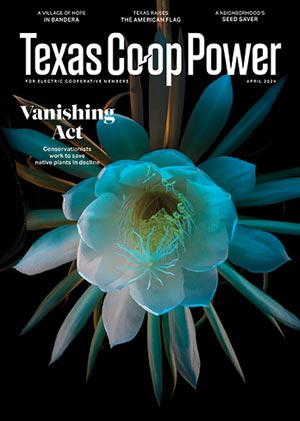In 1915, there appeared in The Roscoe Times the story of a horned rabbit that one W.A. Ater said he killed on his ranch just outside the small town, west of Abilene. Ater took the peculiar creature to the newspaper’s office to show the skeptics he wasn’t lying about the rabbit or its horns.
Sure enough, the little rabbit, a cottontail, had horns—and it wasn’t the first horned rabbit to be found in Texas that year. The newspaper noted that another horned rabbit had been killed in South Texas, near San Benito, which “leads to the conclusion on the part of local scientists that there is a distinct breed of this species.”
While we don’t know what kind of scientific community existed in Roscoe in 1915, we can be certain that Ater did indeed kill a horned rabbit. The news reporter described it thusly: “The rabbit which Mr. Ater killed and brought into town had two horns, each about four inches in length. It presented a grotesque appearance, resembling a miniature deer more than it did a genuine rabbit.”
Newspapers across the state picked up the story, adding editorial embellishments ranging from curiosity to amusement. An Austin paper snickered, “The discovery of two horned rabbits in Texas leads to the suspicion that there is probably a herd of saber-toothed sheep at large in this section.”
Stories of horned rabbits weren’t as rare in 1915 as the skeptics supposed. In fact, they’ve been around about as long as rabbits. Persian texts from the 13th century mention horned rabbits. The Huichol, an Indigenous people of northern Mexico, told of the horned rabbit as a mysterious creature that gave the deer its horns. In 1915 alone, there were more than 150 stories about horned rabbits in newspapers across America. That Roscoe rabbit was no outlier.
The curious folks who gathered in The Roscoe Times office to look at Ater’s peculiar bunny concluded that the horns were not very formidable weapons, whether for offense or defense, and were left to ponder what they were good for. Naturalists didn’t know why some rabbits developed horns.
The answer remained elusive until 1932, when virologist Richard Shope discovered that rabbits sometimes develop “horns” as the result of a virus that creates tumors called fibromas on the skin. The infections probably arise from insect bites on the head and face, which evolve into what has come to be known as the Shope papillomavirus, giving a rabbit the appearance of having horns.
Rabbits typically have an immune response that gets rid of the virus and growths, but occasionally the growths occur around the mouth, hindering the animal’s ability to eat. More importantly, Shope found that rabbits that survived the virus became immune to it. None of the horned rabbits he studied were susceptible to the virus a second time.
Shope passed his research along to Peyton Rous, a friend and colleague in the field of early cancer research, who found that when he injected the virus deep inside rabbits, they died of cancer. This was a big deal—the first time science had linked a cancer to a virus in a mammal.
The discovery opened a new field of cancer research that led to the creation of successful viral cancer therapies, including the human papillomavirus vaccine that protects against cervical and other cancers. Rous’ work earned him the Nobel Prize in medicine in 1966.
Around the same time Shope discovered the papillomavirus in rabbits, brothers Douglas and Ralph Herrick got to messing around in a little amateur taxidermy shop on their Wyoming ranch and mounted the antlers of a small deer to the head of a large jackrabbit, creating a comical “jackalope” creature. The boys sold their version of an antlered rabbit to bar owner Roy Ball for $10, a handsome sum during the Great Depression.
From there the jackalope went on to become the most profitable taxidermy hoax in the world, adorning postcards, T-shirts, barroom and restaurant walls, shot glasses, keychains, and many other kitschy items.
The humble horned rabbit leaves a more noble legacy—helping further cancer research.



